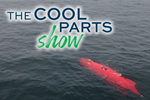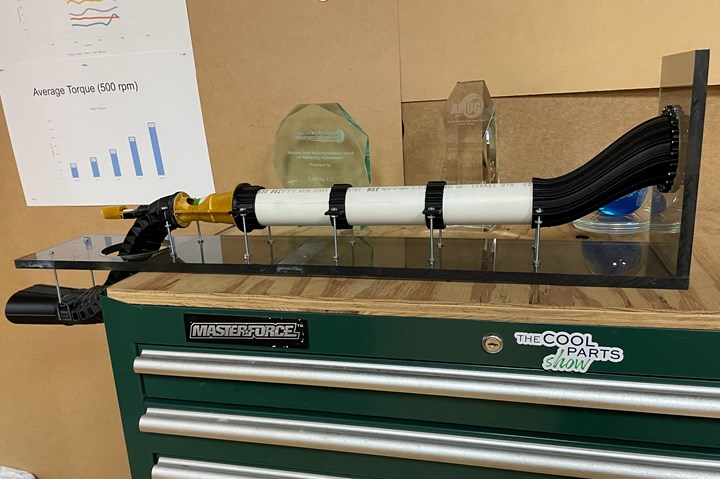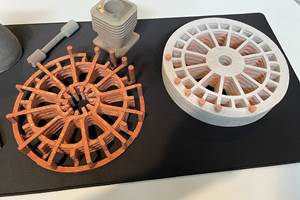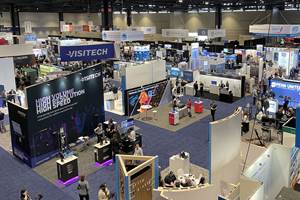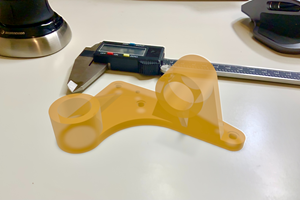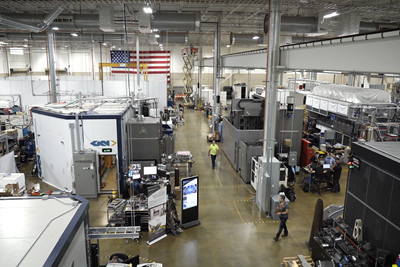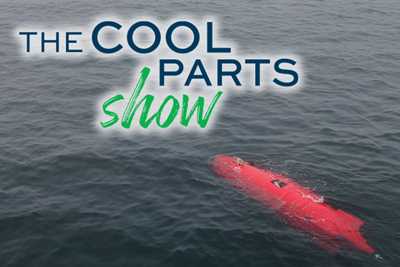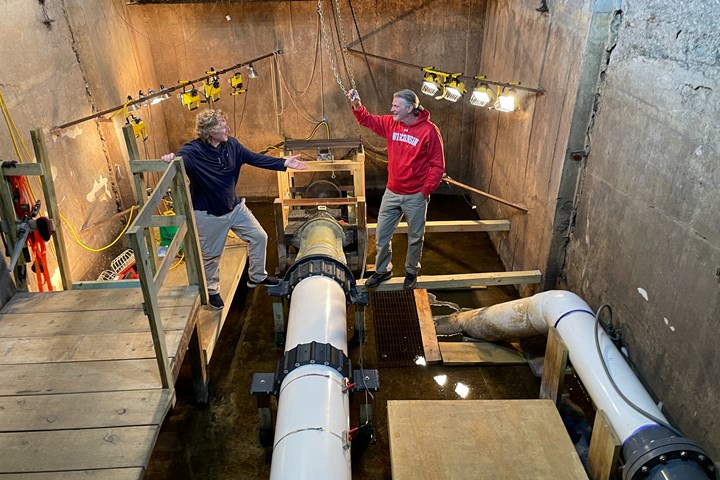
Randal Mueller (right) and Vito Gervasi stand on either side of the micro-hydropower test rig now operating inside the Rome Feed Mill. Cadens is developing a platform so that small-scale turbine systems like this could be deployed across the United States and beyond for distributed renewable electricity.
For nearly two centuries, the water of the Bark River has been corralled to form a pond in Sullivan, Wisconsin. The dam that was installed in 1842 (predating Wisconsin’s statehood by a handful of years) created the Rome Pond and made it possible to power first a sawmill and later a grist mill just downstream. The Rome Feed Mill building still stands on the site, its exterior speaking to an earlier time. But inside, a clean energy startup is working on a solution that could be the next evolution of hydropower.
The historic Rome Feed Mill in former village of Rome, now part of Sullivan. Milling operations were first established at this site in 1842; today, it is home to Cadens’ micro-hydropower test bed. The present building dates to 1924 per records of the Wisconsin Historical Society. Photo Credit: Randal Mueller
“There are between 80,000 and 90,000 dams in the United States, but only a few thousand of them produce electricity,” says Randal Mueller of Cadens, the company that now occupies the mill building. The number of powered dams is even lower for low- and ultra-low-head systems — that is, dams with a “head” or drop in elevation of less than 30 and 10 feet, respectively. The head at the Rome dam (seen in the image at the top of this story) is just 9 feet, placing it in the ultra-low head category.
For over a decade now, Cadens has been exploring how to apply water turbines to generate electricity from small dams like this, which have been largely overlooked as sources of hydroelectric power. Building smaller turbine systems sized to these low-head dams requires an understanding of the waterway’s average flow (easy to glean from historic data) but also an understanding of the water’s fluid dynamics and how to build the necessary components around that flow (not so easy to determine, and harder to customize for lower heads). Cadens originally began to work on the first challenge with with a software solution for predictive turbine design based on reduced order code. Additive manufacturing (AM) came later, but has proven to be the manufacturing process most capable of affordably producing the large, custom components needed to adapt a water turbine system to its environment.
A Mill Site Reclaimed
Matching turbine equipment to waterways has likely been a challenge for as long as humans have used waterpower to turn millstones and the like. Local lore holds that Sullivan’s nineteenth-century mill operators would sometimes hold back the upstream flow until enough volume built up in the Rome Pond to turn the waterwheel, starving the streambed and stranding fish downstream while causing flooding above the dam. The reason for this water management strategy? The mill’s wheel was too large for the average flow of the river, and needed more water to turn than was always available. Then as now, customized components could be difficult to come by.
The Rome Feed Mill, head race and tail race, pond and dam (see the map above) remained in place even after the mill went out of use, and the infrastructure suffered significant damage in 2008 when a historic flood hit the lower half of Wisconsin. In its wake, Mueller (a trained jazz musician who had been introduced to the promise of micro-hydropower by a friend years before) secured a community development block grant for the town of Sullivan for flood mitigation and invested many volunteer hours in the restoration efforts. In 2009, he and two partners arranged a short lease of the mill to test prototypes of a novel waterwheel system for hydroelectric power that ultimately did not deliver the expected results.
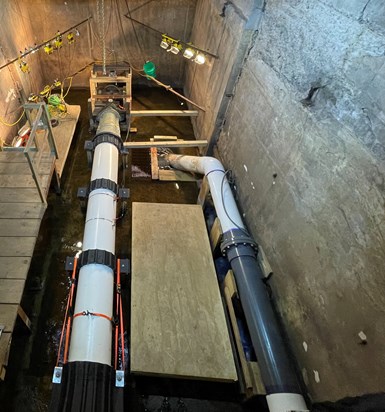
The Cadens test rig is in the basement of the mill (the flume), where a millwheel used to drive a set of millstones for grinding grain. The water enters the system through the intake adapter at the bottom of the image, then flows through the system and exits via a draft tube that extends below the floor and out to the tail race.
Cadens was officially founded several years later in 2011. After searching for and failing to acquire an affordable low-head micro-hydro system for the mill site, Mueller realized the company needed to take a different approach, and that advancing micro-hydropower would require more than dropping existing equipment into new sites. Instead, Cadens focused first on developing turbine design software based on reduced order code to help optimize and design systems geared specifically toward site-specific solutions.
It wasn’t until 2015 that Cadens found the hardware solution it was lacking, in BAAM — Big Area Additive Manufacturing, the technology since commercialized by Cincinnati Inc. After seeing BAAM in action during a site visit to Oak Ridge National Laboratory (ORNL), Cadens teamed up with Lonnie Love and others at the Department of Energy lab to apply the large-format 3D printing technology to building physical systems based on guidance from the turbine design software. In 2017, Vito Gervasi joined the Cadens team, bringing nearly three decades of expertise in design for additive manufacturing (DFAM) and serving as the missing link necessary to move from digital designs to physical printed parts.
3D Printed Parts for Micro-Hydropower
Several years later in 2022, Cadens has completed phase one of a CRADA (Cooperative Research and Development Agreement) with Oak Ridge, which involved using its software tools and the lab’s BAAM capacity to build a functioning test bed. That system has been successfully operating at the Rome Mill for nearly two years now; its critical 3D printed components can be seen below:
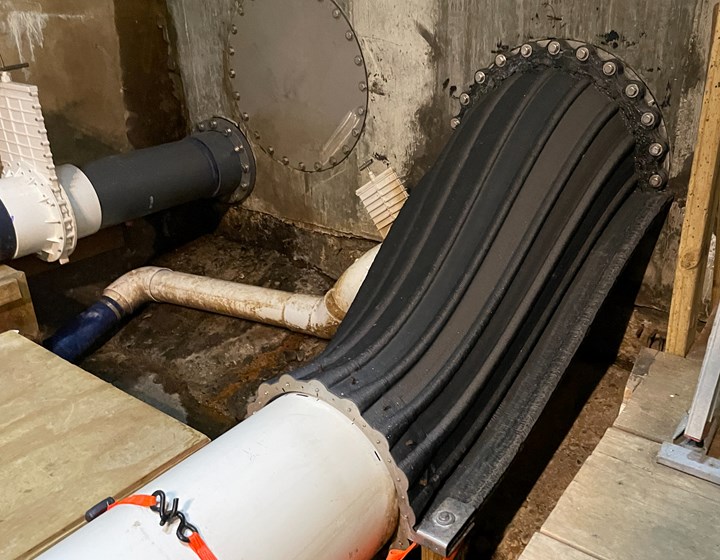
Intake Adapter
This large component sits up against one of three existing openings (or “thimbles”) inside the mill’s flume that allow water from the head race fed by the Rome Pond into the system. (The valve inside the thimble is controlled manually, with a wheel on the platform above that can be turned to open its gate.) The hollow ribs built into the component’s walls have metal reinforcements inside, added to ensure that the part wouldn’t delaminate in use. The adapter’s design is geared toward lowering the centerline of the turbine position and establishing a smooth flow from the water source to feed the turbine system; turbulence leads to lost energy and can even contribute to cavitation that could eat away at the components.

Pipe Support Stands
These two collars fit around the system’s 20"-diameter PVC pipe and attach to wooden supports anchored to the floor. The supports help the pipe remain rigid across its 15-foot length, again critical for avoiding turbulence and vibration when it is full of nearly 1,000 pounds of water during use. (The pipe itself is longer than strictly necessary, but the extra length allowed Cadens to attach sensors seen above to gather data about the amount of water flowing through.)

End Cap Flange
This piece attaches the PVC pipe to the runner housing. An O-ring inside seals the pipe to the housing. Like the other BAAM printed parts in the system, the flange is made from chopped carbon fiber-reinforced ABS and was finished on the inside using a belt sander to smooth the surface and avoid creating turbulence.

Draft Tube
The draft tube begins here inside the building, then extends below the floor level and exits the mill below the waterline in the tail race to return the flow to the river. (See the pulley that drives the generator above where the tube drops away.) Unlike the other monolithic prints shown above, the draft tube is a clamshell construction of two halves that were joined together on site. The cross-section changes along the tube’s length, beginning with a round geometry, then transitioning to oval and finally a stadium shape — a shift that would be difficult and expensive to replicate with any other manufacturing method. It also has about a 35-degree slope which is steeper than standard; “12 degrees is ideal,” Mueller says, “but I didn’t want to chip away the concrete to make it fit.” Every waterway and dam is unique, and the Rome Mill is no different; this concession to the environment is just one of many possible design modifications that 3D printing could support for these systems.
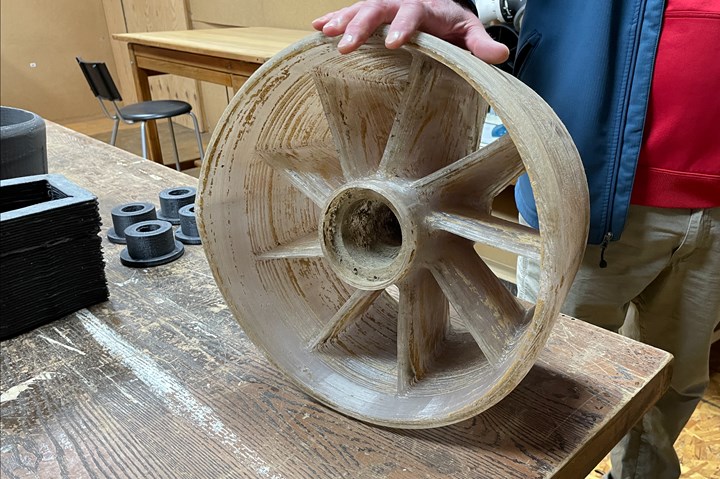
Pre-Swirl Stator
Not all of the 3D printed components key to this test rig were made with BAAM. The pre-swirl stator inside the housing is similar to the one seen here; it was 3D printed from PETG on a more conventional extrusion-style 3D printer.

Runner
The 3D printed runner inside the housing has been through multiple iterations and materials. From left to right: four-blade PLA runner; five-blade Ultem 1010 runner; eight-blade PLA runner; and three-blade carbon fiber-PETG runner.
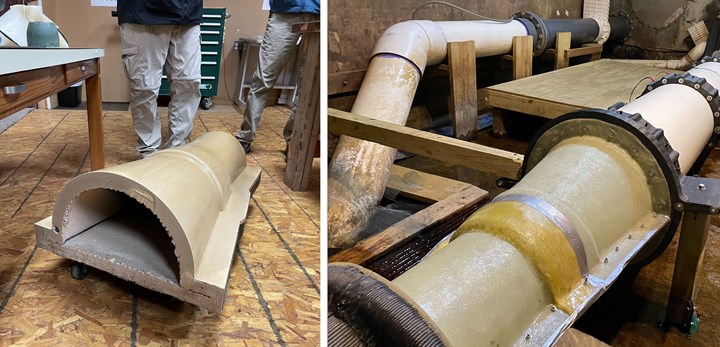
3D printed tooling also played a role in the creation of the test bed. A mold 3D printed on the BAAM (left) was used to create the fiberglass layup for the runner housing (right). The housing was designed as two mirrored halves, and so Mueller and Gervasi used the same mold twice to build the two pieces by hand.
Would it have been possible to build this same test bed with off-the-shelf components? Technically yes, but it would not work so well or be as affordable. “We could have used standard elbow joints for the intake adapter for example,” Gervasi says, “but it would have cost $9,000 for two elbows and a reduced coupling would be needed too.” Along with the cost, twisting the water through 90-degree corners would also cause head loss and reduce the amount of power possible to achieve from the average volume of water available. With BAAM, Cadens was able to 3D print the entire intake adapter for only $1,500, in a design that is optimized to avoid head loss and precisely fitted to the existing thimble setup. Using a combination of custom 3D printed parts and some off-the-shelf components, the entire test bed cost just $18,000 to produce.
Micro-Hydro As Part of the Microgrid
The test bed currently installed in the Rome Feed Mill is a 6.5-kW system. It creates more than enough to power the lights strung around the generator, and to run two Flashforge desktop 3D printers in the workshop upstairs. The next phase of this project will move the test bed to a different thimble in the same space and build a new, 10-kW water turbine system alongside it. The increased power will allow Cadens to add more printers to its workshop, ultimately expanding that capacity into a makerspace and manufacturing facility for original products, customer parts and additional hydropower components.
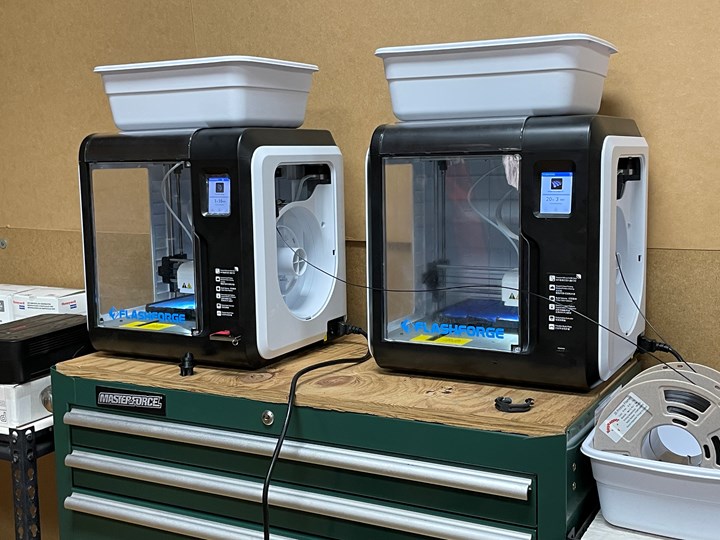
These two desktop 3D printers powered by the water turbine could be the first of many at this location. As Cadens scales up its electricity output, the company also intends to make the mill building into a makerspace and production facility. Consumer products, industrial parts and more hydropower components for new systems could all be made here.
“We want this system to be self-replicating,” Gervasi says. Electricity generated using 3D printed turbine components can be used to manufacture the next generation of water turbine systems. In fact, this is already happening.
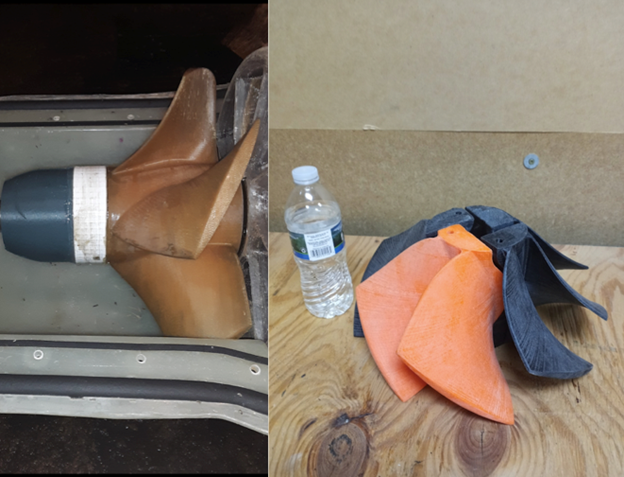
One example of how Cadens’ microgrid sustains and improves itself. Electricity generated by the testbed from the runner on the left (made of Ultem 1010) was used to print the runner on the right (PLA) that in turn was used on the testbed. Photo Credit: Randal Mueller
The company also plans to add a battery to store electricity that is not needed immediately, as well as solar panels to the top of the mill to transform the building into its own microgrid. While Cadens will not detach itself from standard utilities, its microgrid setup will allow it to spend less on conventional electricity and ensure that 3D prints can continue uninterrupted should something interfere with the main grid. In fact, the day I visited the company received a notice that electricity would be shut down for a few hours later that week for maintenance — a situation that would disrupt production for most shops, but is not a problem for a manufacturing facility with its own power generation capability.
(Selling excess electricity back to the conventional grid could also be a possibility for the Rome mill, but Mueller isn’t particularly interested in this option. “Hopefully we’ll use all that power ourselves,” he says, citing the expansion plans. If some of the product designs Gervasi has in the works pan out, the site could need 40 desktop printers or more for production. The next 10-kW set up could support up to 150 small printers like this, Gervasi says, or a few large ones.)
But the big picture for ultra-low-head hydropower gets beyond Cadens and beyond Sullivan, Wisconsin. What Cadens aims to provide is a platform for easily designing and implementing these small hydropower systems across the country and the world, to help reduce reliance on fossil fuels and increase access to renewable energy. Using the turbine design software to establish the flow of unique waterways, Gervasi or another designer can create 3D printable components built around that flow to transfer water smoothly through a water turbine system customized for the location — whether that be existing unpowered dams, new public hydropower initiatives, privately owned dams for small manufacturing facilities or remote locations not near an electric grid. The components can be made through large-format extrusion 3D printing and installed on-site. And more individual manufacturers, companies, municipalities or other interested parties can adopt hydropower with both a small footprint and price tag.
Related Content
Multimaterial 3D Printing with Conventional Powder Metallurgy
Unbound sand serves as temporary, reusable molds for metal powders in Grid Logic’s 3D printing process.
Read MoreAdditive Wins on Cost, Plus Process Monitoring and More from RAPID + TCT 2023: AM Radio #38
Additive manufacturing is finding success as a cost-effective manufacturing method. New options for process monitoring are now available. DED is getting more precise. 3D printed chairs! What we learned and observed at RAPID + TCT 2023.
Read MoreEvaluating the Printability and Mechanical Properties of LFAM Regrind
A study conducted by SABIC and Local Motors identified potential for the reuse of scrap reinforced polymer from large-format additive manufacturing. As this method increases in popularity, sustainable practices for recycling excess materials is a burgeoning concern.
Read MoreWhy This Photopolymer Developer Wants Prototyping to Go “Massless”
High-performance materials supplier polySpectra is embracing augmented reality (AR) with a new tool called Massless intended to reduce unnecessary 3D printing.
Read MoreRead Next
Video: What is the Manufacturing Demonstration Facility at Oak Ridge National Laboratory?
This industry-focused organization within the Department of Energy helps manufacturers make use of advanced technology, particularly 3D printing. One of the group’s leaders describes how companies work with the MDF.
Read MoreAutonomous Underwater Vehicle With 3D Printed Hull: The Cool Parts Show #24
Our first episode of The Cool Parts Show from inside a 3D printer! Big Area Additive Manufacturing (BAAM) produces exterior components of a robot submarine and changes how this AUV is marketed.
Read MoreMeet the Finalists in The Cool Parts Showcase
Three of these finalist parts will be featured in upcoming episodes of The Cool Parts Show.
Read More

.jpg;width=70;height=70;mode=crop)

